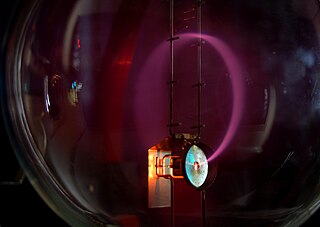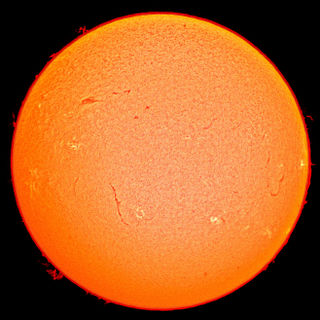
A linear particle accelerator is a type of particle accelerator that accelerates charged subatomic particles or ions to a high speed by subjecting them to a series of oscillating electric potentials along a linear beamline. The principles for such machines were proposed by Gustav Ising in 1924, while the first machine that worked was constructed by Rolf Widerøe in 1928 at the RWTH Aachen University. Linacs have many applications: they generate X-rays and high energy electrons for medicinal purposes in radiation therapy, serve as particle injectors for higher-energy accelerators, and are used directly to achieve the highest kinetic energy for light particles for particle physics.
Time of flight (ToF) is the measurement of the time taken by an object, particle or wave to travel a distance through a medium. This information can then be used to establish a time standard, as a way to measure velocity or path length, or as a way to learn about the particle or medium's properties. The traveling object may be detected directly or indirectly.

An electron gun is an electrical component in some vacuum tubes that produces a narrow, collimated electron beam that has a precise kinetic energy. The largest use is in cathode ray tubes (CRTs), used in nearly all television sets, computer displays and oscilloscopes that are not flat-panel displays. They are also used in field emission displays (FEDs), which are essentially flat-panel displays made out of rows of extremely small cathode ray tubes. They are also used in microwave linear beam vacuum tubes such as klystrons, inductive output tubes, travelling wave tubes, and gyrotrons, as well as in scientific instruments such as electron microscopes and particle accelerators. Electron guns may be classified by the type of electric field generation, by emission mechanism, by focusing, or by the number of electrodes.

Quadrupole magnets, abbreviated as Q-magnets, consist of groups of four magnets laid out so that in the planar multipole expansion of the field, the dipole terms cancel and where the lowest significant terms in the field equations are quadrupole. Quadrupole magnets are useful as they create a magnetic field whose magnitude grows rapidly with the radial distance from its longitudinal axis. This is used in particle beam focusing.

Gradient-index (GRIN) optics is the branch of optics covering optical effects produced by a gradient of the refractive index of a material. Such gradual variation can be used to produce lenses with flat surfaces, or lenses that do not have the aberrations typical of traditional spherical lenses. Gradient-index lenses may have a refraction gradient that is spherical, axial, or radial.
Particle image velocimetry (PIV) is an optical method of flow visualization used in education and research. It is used to obtain instantaneous velocity measurements and related properties in fluids. The fluid is seeded with tracer particles which, for sufficiently small particles, are assumed to faithfully follow the flow dynamics. The fluid with entrained particles is illuminated so that particles are visible. The motion of the seeding particles is used to calculate speed and direction of the flow being studied.

A teltron tube (named for Teltron Inc., which is now owned by 3B Scientific Ltd.) is a type of cathode ray tube used to demonstrate the properties of electrons. There were several different types made by Teltron including a diode, a triode, a Maltese Cross tube, a simple deflection tube with a fluorescent screen, and one which could be used to measure the charge-to-mass ratio of an electron. The latter two contained an electron gun with deflecting plates. The beams can be bent by applying voltages to various electrodes in the tube or by holding a magnet close by. The electron beams are visible as fine bluish lines. This is accomplished by filling the tube with low pressure helium (He) or Hydrogen (H2) gas. A few of the electrons in the beam collide with the helium atoms, causing them to fluoresce and emit light.

Electron optics is a mathematical framework for the calculation of electron trajectories along electromagnetic fields. The term optics is used because magnetic and electrostatic lenses act upon a charged particle beam similarly to optical lenses upon a light beam.

The mass-to-charge ratio (m/Q) is a physical quantity that is most widely used in the electrodynamics of charged particles, e.g. in electron optics and ion optics. It appears in the scientific fields of electron microscopy, cathode ray tubes, accelerator physics, nuclear physics, Auger electron spectroscopy, cosmology and mass spectrometry. The importance of the mass-to-charge ratio, according to classical electrodynamics, is that two particles with the same mass-to-charge ratio move in the same path in a vacuum, when subjected to the same electric and magnetic fields. Its SI units are kg/C. In rare occasions the thomson has been used as its unit in the field of mass spectrometry.

The Townsend discharge or Townsend avalanche is a gas ionisation process where free electrons are accelerated by an electric field, collide with gas molecules, and consequently free additional electrons. Those electrons are in turn accelerated and free additional electrons. The result is an avalanche multiplication that permits electrical conduction through the gas. The discharge requires a source of free electrons and a significant electric field; without both, the phenomenon does not occur.
An electrostatic analyzer or ESA is an instrument used in ion optics that employs an electric field to allow the passage of only those ions or electrons that have a given specific energy. It usually also focuses these particles into a smaller area. ESA’s are typically used as components of space instrumentation, to limit the scanning (sensing) energy range and, thereby also, the range of particles targeted for detection and scientific measurement. The closest analogue in photon optics is a filter.

Low-energy ion scattering spectroscopy (LEIS), sometimes referred to simply as ion scattering spectroscopy (ISS), is a surface-sensitive analytical technique used to characterize the chemical and structural makeup of materials. LEIS involves directing a stream of charged particles known as ions at a surface and making observations of the positions, velocities, and energies of the ions that have interacted with the surface. Data that is thus collected can be used to deduce information about the material such as the relative positions of atoms in a surface lattice and the elemental identity of those atoms. LEIS is closely related to both medium-energy ion scattering (MEIS) and high-energy ion scattering, differing primarily in the energy range of the ion beam used to probe the surface. While much of the information collected using LEIS can be obtained using other surface science techniques, LEIS is unique in its sensitivity to both structure and composition of surfaces. Additionally, LEIS is one of a very few surface-sensitive techniques capable of directly observing hydrogen atoms, an aspect that may make it an increasingly more important technique as the hydrogen economy is being explored.
In physics, Gauss's law for gravity, also known as Gauss's flux theorem for gravity, is a law of physics that is essentially equivalent to Newton's law of universal gravitation. It is named after Carl Friedrich Gauss. Although Gauss's law for gravity is equivalent to Newton's law, there are many situations where Gauss's law for gravity offers a more convenient and simple way to do a calculation than Newton's law.

A magnetic lens is a device for the focusing or deflection of moving charged particles, such as electrons or ions, by use of the magnetic Lorentz force. Its strength can often be varied by usage of electromagnets.

A Wien filter also known as velocity selector is a device consisting of perpendicular electric and magnetic fields that can be used as a velocity filter for charged particles, for example in electron microscopes and spectrometers. It is used in accelerator mass spectrometry to select particles based on their speed. The device is composed of orthogonal electric and magnetic fields, such that particles with the correct speed will be unaffected while other particles will be deflected. It is named for Wilhelm Wien who developed it in 1898 for the study of anode rays. It can be configured as a charged particle energy analyzer, monochromator, or mass spectrometer.
SIMION is an ion optics simulation program that calculates electric fields for electrodes of defined voltages and ion trajectories in those fields.

A reflectron is a type of time-of-flight mass spectrometer that comprises a pulsed ion source, field-free region, ion mirror, and ion detector and uses a static or time dependent electric field in the ion mirror to reverse the direction of travel of the ions entering it. Using the reflectron, one can substantially diminish a spread of flight times of the ions with the same mass-to-charge ratio (m/z) caused by spread in kinetic energy of these ions measured at the exit from the ion source.

A non-neutral plasma is a plasma for which the total charge is sufficiently different from zero, so that the electric field created by the un-neutralized charge plays an important or even dominant role in the plasma dynamics. The simplest non-neutral plasmas are plasmas consisting of a single charge species. Examples of single species non-neutral plasmas that have been created in laboratory experiments are plasmas consisting entirely of electrons, pure ion plasmas, positron plasmas, and antiproton plasmas.
Fluid motion can be said to be a two-dimensional flow when the flow velocity at every point is parallel to a fixed plane. The velocity at any point on a given normal to that fixed plane should be constant.
























